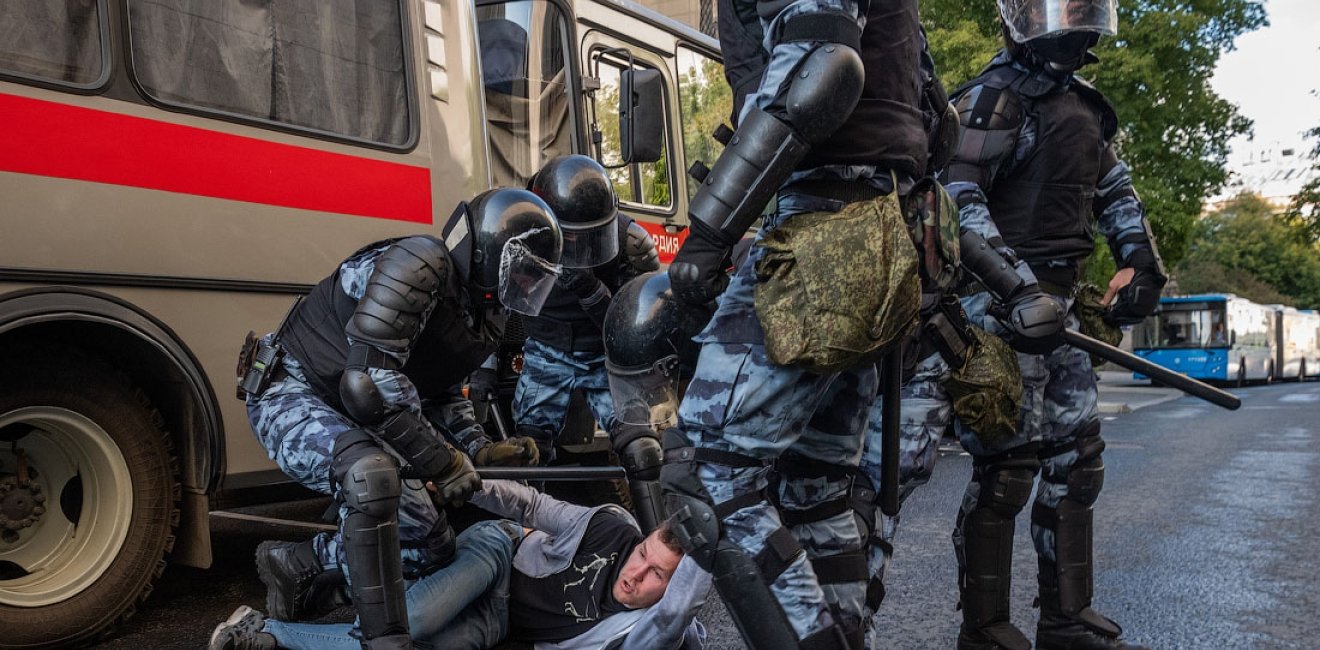
A blog of the Kennan Institute
BY MAXIM TRUDOLYUBOV
Over the past weekend, thousands of Muscovites took to the streets to demand that independent candidates be allowed to run for seats on the Moscow city council. More than 1,000 people were detained, according to OVD-Info, an NGO that monitors detentions and provides legal help to those arrested. The weekend before, at least 10,000 protested, and more than 1,300 were detained.
Those figures might evoke images of trashed shop windows, overturned, burning cars, and streets littered with debris. Why else would police arrest so many people? But nothing of the kind happened. Hundreds of protests, large and small, have taken place in Russia since last year’s unpopular retirement-age reform, yet instances of violence on the part of protesters are extremely rare. Moscow’s protest actions are among the cleanest.
What strikes observers is the culture of public action that has emerged in Russia during the past several years. A common feature of all kinds of protests—those against hazardous landfills near cities, against construction in public spaces, or for access to elections—is the absence of violence. Most of the demonstrations these days do not have clear leaders, yet they are self-disciplined, calm, and goal-oriented.
The cases of violence (a plastic bottle or a trash can thrown at a policeman, pepper spray deployed against police) that the authorities are now using to bolster their assertion that “mass rioting” took place are highly suspect. Many think that those who were throwing things may have been hired provocateurs.
Harsh anti-extremism laws are a factor conditioning this restrained behavior. Even touching a policeman may be interpreted by the courts as an assault on a representative of authority that is punishable by years in prison. In most cases the prosecution’s witnesses, who are often policemen themselves, prevail against the defendant’s witnesses in court. But this is not the only reason for Russia’s culture of protest.
Most of those who dare join an unauthorized protest (permission for any public gathering must be sought from and granted by the local authorities in advance) understand that the only thing they can control is their own behavior. Police officers or investigators may break the law, but members of the public cannot afford this luxury. Some police officers—even hired provocateurs—may try to rouse people to let off steam, but everyone understands that anger management skills are paramount.
OVD-Info, the detentions monitoring NGO, has circulated recommendations for those who might be arrested. The guidelines read like a program for meditation. A detained person, the text says, should be like “a thousand calm elephants.” “Take a deep breath, make a call to OVD-Info … do not argue with the police, unemotionally ask for their names … slowly read your arrest protocol before signing anything. You have two options: invoke Article 51 (the right not to bear witness against oneself) or carefully point out all misrepresented facts and transgressions and make sure they are included. Then sign. This is the teaching of OVD-Info.”
On July 27, at least 10,000 people (some estimates put it at 15,000 to 20,000) showed up for an unauthorized protest demanding that the electoral commission allow independent candidates to run for seats on the Moscow city council. On Wednesday, the Investigative Committee initiated criminal proceedings and started arresting and charging demonstrators with “participation in mass riots.” This past weekend’s protest was followed by more charges along the same lines.
And yet all that was happening in Moscow on July 27, as well as on August 3, did not look remotely like the violent unrest you see on the news from places like Paris or Hong Kong. Insults were occasionally thrown at the police but, on balance, the public was a lot more reserved than members of Russia’s riot police force, who did not hesitate to use their batons, violently grab demonstrators, and forcefully drag them to police wagons.
This past weekend was especially gruesome. The results of the previous weekend and a campaign to scare off people from joining an unauthorized protest brought the numbers of those who took a defiant walk along Moscow’s boulevards down to a minimum. Two large music festivals were held on that same day in other parts of Moscow. Yet, from 1,500 to a few thousand were estimated to be outside on August 3 and about 1,000 people were detained, including innocent bystanders, while nineteen were beaten up, OVD-Info said.
The exact numbers of participants are hard to ascertain because people were dispersed along the boulevards and, by intention, did not have a leader or a clear plan for an organized demonstration. Most of those detained were let go in the evening, but dozens were arrested for longer periods, and some of them now face charges of rioting. Again, all observers are certain that no real rioting actually took place. Moscow’s boulevards looked deserted … and very clean after the police operation was complete.
The disproportionate use of force by the police has a number of explanations. The Kremlin is known for its low tolerance of unauthorized public protest. Any public gathering with a political agenda is labeled a “Maidan,” in reference to the Ukrainian standoffs with the police during the Euromaidan Revolution in 2014. It is hard to judge whether it is sincere, but Russia’s political management treats all unauthorized political action as inspired and funded by the West.
And yet people kept going out into the streets even though literally everyone who could be considered an organizer of the protest was arrested and jailed in advance. The protesters’ demands were very focused and clear: let the electoral commission allow our candidates run for seats on Moscow’s city council. Only a few of those prospective candidates had any real chance of winning.
Still, the Moscow city government was leaning over backward to prevent anyone unauthorized from running for a seat on relatively obscure organ that had little decision-making power. But council members do have the right to review the city’s budget, and most observers think this was the reason why the authorities were adamantly against letting outsiders in. In 2018, the city of Moscow’s expenditures reached 2.3 trillion rubles ($35 billion) a year.
This year’s protest in Moscow feels very different from the protests in 2011 and 2012. The public’s demands are focused and specific, the protesters’ behavior is restrained. And the authorities are reacting as if they were dealing with a mass revolt. Today’s economic situation is much worse than in 2011. Russia is in its sixth consecutive year of falling incomes. This can only mean that the Kremlin is expecting people to be ready to go out and protest and are trying to frighten them off from even thinking about it.
Author

Editor-at-Large, Meduza

Kennan Institute
After more than 50 years as a vital part of the Wilson Center legacy, the Kennan Institute has become an independent think tank. You can find the current website for the Kennan Institute at kennaninstitute.org. Please look for future announcements about partnership activities between the Wilson Center and the Kennan Institute at Wilson Center Press Room. The Kennan Institute is the premier US center for advanced research on Eurasia and the oldest and largest regional program at the Woodrow Wilson International Center for Scholars. The Kennan Institute is committed to improving American understanding of Russia, Ukraine, Central Asia, the South Caucasus, and the surrounding region through research and exchange. Read more

Explore More in The Russia File
Browse The Russia File
Chechnya as a Model of Modern Russia

Russia’s Indigenous Communities and the War in Ukraine

Gas and Power in a Changing US–Russia Relationship

